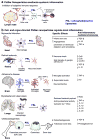"Eat me" imaging and therapy
- PMID: 26826436
- PMCID: PMC4865253
- DOI: 10.1016/j.addr.2016.01.009
"Eat me" imaging and therapy
Abstract
Clearance of apoptotic debris is a vital role of the innate immune system. Drawing upon principles of apoptotic clearance, convenient delivery vehicles including intrinsic anti-inflammatory characteristics and specificity to immune cells can be engineered to aid in drug delivery. In this article, we examine the use of phosphatidylserine (PtdSer), the well-known "eat-me" signal, in nanoparticle-based therapeutics making them highly desirable "meals" for phagocytic immune cells. Use of PtdSer facilitates engulfment of nanoparticles allowing for imaging and therapy in various pathologies and may result in immunomodulation. Furthermore, we discuss the targeting of the macrophages and other cells at sites of inflammation in disease. A thorough understanding of the immunobiology of "eat-me" signals is requisite for the successful application of "eat-me"-bearing materials in biomedical applications.
Keywords: Drug delivery; Imaging; Immune response; Leukocytes; Liposomes; Phagocytes; Phosphatidylserine.
Copyright © 2016 Elsevier B.V. All rights reserved.
Figures

Similar articles
-
"Find Me" and "Eat Me" signals: tools to drive phagocytic processes for modulating antitumor immunity.Cancer Commun (Lond). 2024 Jul;44(7):791-832. doi: 10.1002/cac2.12579. Epub 2024 Jun 23. Cancer Commun (Lond). 2024. PMID: 38923737 Free PMC article. Review.
-
Friendly fire against neutrophils: proteolytic enzymes confuse the recognition of apoptotic cells by macrophages.Biochimie. 2008 Feb;90(2):405-15. doi: 10.1016/j.biochi.2007.09.008. Epub 2007 Sep 22. Biochimie. 2008. PMID: 17964056 Review.
-
An Apoptotic 'Eat Me' Signal: Phosphatidylserine Exposure.Trends Cell Biol. 2015 Nov;25(11):639-650. doi: 10.1016/j.tcb.2015.08.003. Epub 2015 Oct 1. Trends Cell Biol. 2015. PMID: 26437594 Review.
-
Clearance of Apoptotic Cells and Pyrenocytes.Curr Top Dev Biol. 2015;114:267-95. doi: 10.1016/bs.ctdb.2015.07.017. Epub 2015 Sep 11. Curr Top Dev Biol. 2015. PMID: 26431571 Review.
-
Surface code--biophysical signals for apoptotic cell clearance.Phys Biol. 2013 Dec;10(6):065007. doi: 10.1088/1478-3975/10/6/065007. Epub 2013 Dec 4. Phys Biol. 2013. PMID: 24305041 Review.
Cited by
-
Nanomaterials-Based Novel Immune Strategies in Clinical Translation for Cancer Therapy.Molecules. 2023 Jan 26;28(3):1216. doi: 10.3390/molecules28031216. Molecules. 2023. PMID: 36770883 Free PMC article. Review.
-
Liposomes used as a vaccine adjuvant-delivery system: From basics to clinical immunization.J Control Release. 2019 Jun 10;303:130-150. doi: 10.1016/j.jconrel.2019.04.025. Epub 2019 May 3. J Control Release. 2019. PMID: 31022431 Free PMC article. Review.
-
Recent Developments in Drug Delivery for Treatment of Tuberculosis by Targeting Macrophages.Adv Ther (Weinh). 2022 Jun;5(6):2100193. doi: 10.1002/adtp.202100193. Epub 2022 Mar 9. Adv Ther (Weinh). 2022. PMID: 36203881 Free PMC article.
-
Ghost messages: cell death signals spread.Cell Commun Signal. 2023 Jan 9;21(1):6. doi: 10.1186/s12964-022-01004-0. Cell Commun Signal. 2023. PMID: 36624476 Free PMC article. Review.
-
A Low-Modulus Phosphatidylserine-Exposing Microvesicle Alleviates Skin Inflammation via Persistent Blockade of M1 Macrophage Polarization.Int J Mol Sci. 2025 Jan 4;26(1):394. doi: 10.3390/ijms26010394. Int J Mol Sci. 2025. PMID: 39796248 Free PMC article.
References
-
- Henson PM, Hume DA. Apoptotic cell removal in development and tissue homeostasis. Trends Immunol. 2006;27(5):244–250. - PubMed
-
- Lauber K, et al. Clearance of Apoptotic Cells: Getting Rid of the Corpses. Mol Cell. 2004;14(3):277–287. - PubMed
-
- Bianchi ME. DAMPs, PAMPs and alarmins: All we need to know about danger. J Leukoc Biol. 2007;81(1):1–5. - PubMed
Publication types
MeSH terms
Substances
Grants and funding
LinkOut - more resources
Full Text Sources
Other Literature Sources
Molecular Biology Databases

